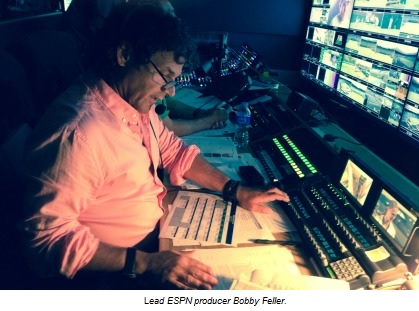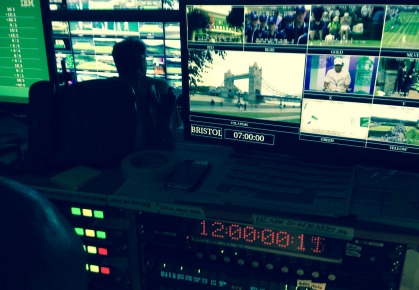By Blair Henley | Tuesday, June 24, 2014
Planning on watching the action at Wimbledon? Get an inside look at how ESPN brings you two glorious weeks of coverage from the All England Club.
(Photo Courtesy: ESPN)
10…9…8…7…6…
When a countdown begins, we’re conditioned to brace ourselves for something big. Even if we know exactly what to expect when the clock strikes 0:00 – a blastoff, a new year, an explosion – the anticipation leading up to the event is palpable.
Walk into an ESPN production trailer during a tennis tournament and those adrenaline-inducing countdowns seem to happen every five minutes or so. When producers aren’t counting backwards, they are communicating with their on-air talent, the cameramen, ESPN’s Bristol, Conn., headquarters or each other—loudly. I observed the high-energy atmosphere firsthand during the Sony Open in March. With no light except the glow of the massive wall of monitors at one end of the tiny production trailer, I felt as if I had entered a high-tech bunker where producers pointed their virtual crosshairs at top tennis players instead of the enemy.
While ESPN maintains that feverish pace for the final five days of the Sony Open, they nearly triple that output during the Wimbledon fortnight. As the U.S. television rights holder through 2023, the network has a schedule that includes more than 140 hours of live coverage on ESPN, ESPN2 and ESPNEWS. They will air an additional 1,000 live hours on ESPN3.com, where fans can choose from up to nine courts of action. It’s no wonder they bring a team of around 125 to deliver a constant stream of grass court tennis from one of the most famous sports venues in the world.
 Jamie Reynolds, ESPN Vice President of Event Production, oversees every aspect of the Wimbledon broadcast. Though he’s covered everything from horseracing to the X Games, he likens producing Grand Slam television to a different sporting event: the Tour de France.
Jamie Reynolds, ESPN Vice President of Event Production, oversees every aspect of the Wimbledon broadcast. Though he’s covered everything from horseracing to the X Games, he likens producing Grand Slam television to a different sporting event: the Tour de France.
“You go through the first week, and then you get into the weekend run and the feel changes a little bit. Then you get into the hills and you have to sprint; then you get to the final, and it’s like the last stage,” Reynolds said.
Like many tennis fans, I’ve spent a considerable amount of time planted comfortably on my couch watching the best players in the world compete. It wasn’t until I saw the behind-the-scenes action firsthand that I appreciated the decisions made on a minute-by-minute basis to bring me uninterrupted tennis coverage – Should we show Federer or Serena? What footage should we roll during this rain delay? If this match is a blowout, what filler do we use until the next match starts? Which commentators will call which matches?
Producers are constantly making split-second calls that affect the viewing experience. As ESPN’s tennis media relations specialist Dave Nagle put it: “There’s no backspace or white-out or second chances!”
Divergent Tools
Reynolds refers to ESPN’s impressive stable of talent during tennis broadcasts as “divergent tools, social currency so people will follow you and pay attention.” But determining which tools build the best broadcast can be a sensitive undertaking.
“I plead the fifth,” he said with a smile when asked about the challenges of talent assignments. “It’s an interesting dynamic. You look at all these former players. These are very single-minded, focused individuals. They are taught throughout their lifetime that their opponent is everyone on the other side of the net. The concept of working on a team is different.”
Commentating may seem like an easy transition for one-time pros who have spent years around the sport, but live tennis analysis means being able to say one thing, hear another and think a third. Producers are constantly communicating to the talent in the booth, who must listen, process and maintain a smooth broadcast. Of course, analysts can also speak off-air to the production staff, as I learned by watching Cliff Drysdale and Mary Joe Fernandez.
“You know, I tend to outshine her a little bit, and she gets very defensive,” Drysdale jokingly told producers about Fernandez. “Have you noticed that?”
Ultimately, each decision made by the ESPN production team, regarding on-air talent or otherwise, is geared toward maintaining engagement. “It’s waiting for the fourth quarter of a basketball game. You have to come up with things to make people to stick around and pay attention,” Reynolds said.
Ratings are driven by two factors: the number of viewers and the length of time they watch. The staff working behind the scenes must enhance the action in order to keep fans hooked. During Wimbledon, the ESPN team takes a stock video feed and adds graphics, effects and, of course, on-air talent to better engage viewers and tell a compelling story. ESPN’s telestration specialists create graphics in real time that can help fans understand a certain tactic or pattern of play.
Before Maria Sharapova’s semifinal match in Miami against Serena Williams, Drysdale requested a graphic detailing Sharapova’s serve toss height. Specialists immediately began building the illustration using live footage. Sometimes a pattern of play will emerge mid-match, and the telestration team will need to react on the fly. Elsewhere in the ESPN production compound, people are clipping and compiling notable moments for those dramatic post-match montages we know and love.
Each match is different, which means the presentation formula is constantly changing. The ESPN production team seamlessly adjusts and reacts to the countless rhythm changes within individual matches as well as a full day of tournament play.
Instant Pudding Generation
As a tennis fan, I’ve been guilty of talking to my television during coverage of a given tournament.
“Um, hello! Why are we watching Serena Williams beat [insert player here] 6-0, 6-0 when we could be watching the riveting third set on Court 3?” or “Why are they filming in the studio when there’s live tennis going on?”
In this era of immediate feedback on social media, the consumer din has reached a crescendo. Producers must strike a fine balance.
“You use [social media] as a tool to show that you are engaged and know what the community is talking about,” Reynolds said. “You don’t throw it out there as a beacon of where you need to be, but you need to be in harmony with it.”
 Through their coverage at Wimbledon and their exclusive rights agreement with the US Open beginning in 2015, ESPN aims to eliminate frustrations that can stem from network hopping. Though prioritizing matches and filling dead time will always be a challenge during 10-hour per day telecasts, viewers aren’t left wondering where live tennis can be found when one station wraps up its coverage. Plus, ESPN3.com provides a constant, all-you-can eat buffet of tennis matches to suit every fan’s taste.
Through their coverage at Wimbledon and their exclusive rights agreement with the US Open beginning in 2015, ESPN aims to eliminate frustrations that can stem from network hopping. Though prioritizing matches and filling dead time will always be a challenge during 10-hour per day telecasts, viewers aren’t left wondering where live tennis can be found when one station wraps up its coverage. Plus, ESPN3.com provides a constant, all-you-can eat buffet of tennis matches to suit every fan’s taste.
Jason Bernstein, ESPN’s Senior Director of Programming and Acquisitions, explained the benefits of consolidating coverage.
“If I’m a fan, I say give me my match when I want it,” Bernstein explained. “It’s the instant pudding generation, but it’s real. Where consumption has gone, everything is on demand. We’ve always said at ESPN that we’re not in the business of telling you how to consume, you’re telling us.”
ESPN’s ever-expanding reach allows for the possibility of casting a wider net, drawing in fledgling tennis fans. But in order to keep them interested, a network must produce a quality product.
“There is no way that we can be authentic presenting Indian Wells and Miami any differently than we would with Wimbledon,” Bernstein said. “Fans require authenticity. There is a single narrative, and the credibility factor has to be high.”
Of course, according to ESPN tennis host Chris Fowler, there are some adjustments to be made depending on the event venue. “Different tournaments have different uniforms. Miami is ‘dress for the air from the waist up.’ Wimbledon is different. You dress head-to-toe at the All England Club.”
Family Ties
Before their coverage began at the Sony Open, the core ESPN team shared a meal at Drysdale’s Key Biscayne home. Working together for countless hours in close quarters can unite or divide, but for this group, it’s the former.
“We talk about being a family, and in this business of egomaniacs, we are surprisingly compatible,” Drysdale said. “We’re like a traveling family.”
Bernstein echoed his remarks.
“One of the things we’ve worked on from the business side is bringing that family mentality to the rights holders,” he said. “We’re everywhere that they are. When it all comes together on TV and different platforms, it’s trying to be familial. It’s kind of fun.”
When ESPN nabbed a sports Emmy nomination for its work on the Wimbledon 2013 final, the team shared the honor with the All England Club.
“[The nomination] is not something we did on our own,” Bernstein said. “They trusted in us to use their hallowed grounds and venue and let us showcase the sport in a unique way.”
Utilizing that family feel and a stockpile of resources, ESPN looks to change the way tennis fans consume the game going forward, providing instant tennis pudding and becoming the go-to source for tennis coverage. For now, that means more fans can taste the sweetness of uninterrupted match play, and there’s no better time to do it than during the most famous fortnight in sports.
5…4…3…2…1…
And we’re live. Welcome to Wimbledon.